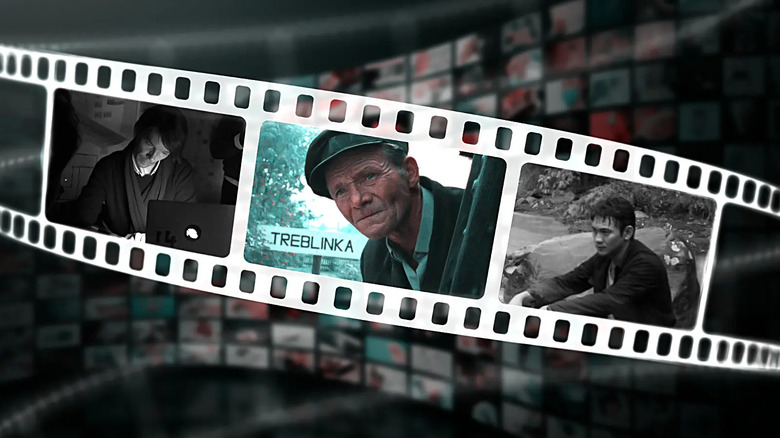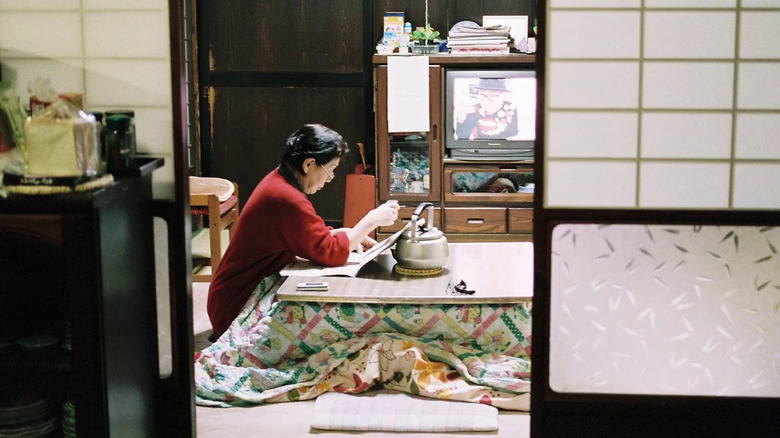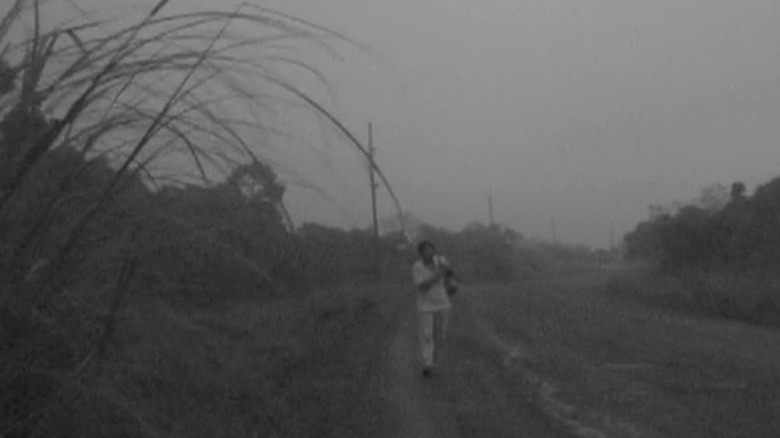
Static Media/Shutterstock
If you were to walk up to somebody 20 years ago and ask them about a film's length, a common consensus was likely to emerge: the longer the runtime, the less appealing it is to watch. In 2024, however, the response might be different. In 2021, the Los Angeles Times reported a study that concluded less than half of moviegoers are dissuaded by lengthy runtimes. In 2023, Slate reported that the average runtime of the 10 highest-grossing movies in the United States was 2 hours and 23 minutes — over 20 minutes longer than 20 years ago. With rising trends in long-form content engagement across film, television, and online video, it has become clear that people are ready for longer viewing experiences, TikTok attention spans be damned.
Most people look at beefy, historical epics like "The Ten Commandments" and "Lawrence of Arabia" as the be-all and end-all of long-form cinema, but those are just the tip of the iceberg. Far longer films have been made and continue to be made but simply aren't seen as widely. They stray far from the beaten path of traditional cinema and reckon with massively expansive ideas. To truly test your might against a long runtime, check out these 15 feats of cinema, the longest movies ever made.
Melancholia (7 hours and 30 minutes)

Sine Olivia
If you're ready to take a deep dive into the longest films ever made, it's time you met Lav Diaz. The Filipino filmmaker is known for his chonky runtimes, to the point that he is on this list not once, not twice, but five times. Fittingly, Diaz is one of the foremost voices in the "slow cinema" movement, which uses long takes, minimal camerawork, and slice-of-life stories to invoke more observation from the viewer.
"Melancholia," like many of Diaz's films, explores Filipino trauma through surrealism. The story, set after an undefined man-made disaster, follows two women engaged in a unique form of roleplay therapy designed by Julian, a man also engaged in the therapy, to help grieve the loss of their loved ones. The bizarre and experimental process does little to console any of them, revealing an unending sadness that Diaz uses to reflect on the Phillippines' long and inescapable history of imperialism. Despite running at seven-and-a-half hours, "Melancholia" was awarded the top prize of the Horizons section at the Venice Film Festival in 2008.
O.J.: Made in America (7 hours and 47 minutes)

Walt Disney Studios Motion Pictures
Surely the most mainstream film on this list, "O.J.: Made in America" is an ESPN-produced documentary charting the rise and fall of footballer-turned-convict O.J. Simpson against the backdrop of growing racial tensions between Black people and the police in 1990s Los Angeles. It's one of the rare bonafide documentaries to rank on this list, using a swath of archival footage and interviews to explore a long and winding history with investigative fervor. It certainly sets itself apart from the many slow cinema entries on this list.
Most people watched "Made in America" across five separate parts either on air or online, making it more of a miniseries than a proper film. Regardless, the film won the Oscar for Best Documentary Feature in 2017, crowning it the longest Oscar-winner ever. It was something so unprecedented that the Academy rewrote the rulebook and made multi-part documentaries no longer eligible from that point forward. However, the film was screened multiple times at its full length of seven hours and 43 minutes, sometimes with two intermissions in-between, so it still qualifies for this list, at least.
The Works and Days (of Tayoko Shiojiri in the Shiotani Basin) (8 hours)

Grasshopper Film
Welcome back to your regularly scheduled slow cinema. We now return with C.W. Winter and Anders Edström's "The Works and Days," a transportive, eight-hours-flat look at the life of Tayoko Shiojiri, a Japanese vegetable farmer living in a remote village in the mountains of Kyoto. The film premiered at the Berlin Film Festival in early 2020, where it was awarded the top prize of its Encounters Competition. The COVID-19 pandemic postponed its proper theatrical release until 2021, after which it ranked in Cinema Scope and Slant's Top 10 lists for that year.
Shot over 27 weeks across 14 months, the film covers five seasons of work with the realism of a documentary, exploring the geography of the village as well as its colorful characters. However, it is also fictional, dramatizing scenes to craft a patient character study of a wary matriarch at the mercy of time. It helps that the real Tayoko is Edström's mother-in-law, giving the film a personal touch.
A Lullaby to the Sorrowful Mystery (8 hours and 5 minutes)

Star Cinema
One of Lav Diaz's newer works, "A Lullaby to the Sorrowful Mystery" begins as a more traditional period piece, a tapestry of intertwining characters and odysseys amidst the Philippine Revolution against colonialist Spain in 1896. Young revolutionaries spar philosophies, while a group searches a mountainous forest for the body of a dead rebel leader. However, it doesn't take too long for Diaz to throw viewers off-guard with some anachronistic elements, such as a trio of tikbalangs (half-horse, half-human creatures) who neigh their way into interfering with our character's journeys.
"Lullaby" is possibly Diaz at his most dramatic, blending the visual languages of historical drama and Shakespearean surrealism into something more tangibly poetic and larger-than-life. However, his dense script still steeps viewers in many conversations confronting the Phillippines' destruction at the hands of the murderous Spaniards and how to move forward. The Berlin Film Festival was taken by Diaz's ambition, awarding the film the Silver Bear in 2016.
Dead Souls (8 hours and 15 minutes)

Grasshopper Film
Our second most-featured filmmaker on this list is Wang Bing, a Chinese documentarian whose works chronicling the social and economic climate of his home country are some of most lauded documentaries in arthouse cinema. They are also some of the longest, accounting for two spots on this list and some that can't even qualify, from 15-hour art installations to a recent trilogy of films, titled "Youth," collectively clocking in at almost 10 hours.
Resting at a comparatively easier eight hours and 15 minutes is 2018's "Dead Souls," a collection of testimonies from survivors of Chinese labor camps enacted during the 1950s. Designed by the country's Communist Party as a way of "re-educating" right-wing civilians (a label they threw around loosely), the camps became hives of mass starvation and death. Bing interviews over 100 survivors, often giving them uninterrupted screentime to simply relay the harrowing details of the torture they endured. It is a tremendously difficult watch — if mostly due to the juxtaposition between the horrifying and the mundane — however, it is an essential oral history that reckons with the still-lingering fallout.
Heremias, Book One: Legend of the Lizard Princess (8 hours, 39 minutes)

Sine Olivia
Lav Diaz crafts a parable on faith and doubt with his next entry on our list, "Heremias." The film centers on an eponymous farmer who serves a group of traveling salesmen. After growing dissatisfied with his life, he and his cow begin traveling alone, thus beginning a long and winding journey that harkens back to Homer's "The Odyssey." He encounters thieves, police officers, priests, and even a group of young men who reveal their plans to rape a young woman and throw her into a river.
The backhalf of "Hermias" primarily focuses on the character's attempts to save her, leading to dead ends with both the church and the police. Disillusioned, Heremias strives to sacrifice himself by going 40 days without food or water. This is where "Book One" ends, leaving the still incomplete "Book Two," subtitled "The Legend of the Invisible Island," to reveal what happens next. Perhaps that film could rank on this list in the future?
If you or anyone you know has been a victim of sexual assault, help is available. Visit the Rape, Abuse & Incest National Network website or contact RAINN's National Helpline at 1-800-656-HOPE (4673).
Death in the Land of Encantos (9 hours)

Sine Olivia
Lav Diaz had shot multiple films in the Bicol region of the Phillippines before Super Typhoon Durian came and devastated the land in 2006. When he returned to capture footage of the destruction for humanitarian purposes, he was gutted. "The smell of death was everywhere," he told Cinema du Reel (via Alexis A. Tioseco). It's fitting then that his project in the aftermath of the disaster is titled "Death in the Land of Encantos." Though it centers on a poet returning to his home country after an exile in Russia, it is but an entrypoint for Diaz to lens the pain and loss that the land and its people had endured.
The film plays out like a slow-moving travelogue, as the poet encounters old friends and flames as he witnesses real-life survivors of Durian and what it left behind. Shot with crisp black-and-white cinematography, a Diaz trademark, we pay witness to not just the endurance of survival but what it means for someone to be displaced by the elements.
Tie Xi Qu: West of the Tracks (9 hours, 11 minutes)

Wang Bing Film Workshop
Wang Bing returns to our list with 2002's "Tie Xi Qu: West of the Tracks," another documentary highlighting a Chinese community left to the fringes. This time, however, his focus is economic strife, a recurring theme throughout his work that is no better crystallized than it is here. The film portrays the history of Tie Xi, an industrial district in northeast China that was once a bustling haven for factory workers and economic opportunity. Since then, however, China's economy has evolved past it. Tie Xi has declined into a something of a wasteland.
The film charts this decline through the lives of the factory workers and their families, many of whom remain working despite the inevitable. Sitting in the shadows of abandoned factories and rail lines, "West of the Tracks" is not coy about its subjects' withering hope. Yet, it can't help but capture them with dignity and humanity, proving their is life beyond capitalist gain no matter how barren it may appear.
Shoah (9 hours, 26 minutes)

mk2 Films
"Shoah," named after the Hebrew word for the Holocaust, is similar to Wang Bing's "Dead Souls" in that it uses testimony to cement history onto celluloid. Released in 1985, the film documents testimonies from countless individuals involved in the Holocaust — including both survivors and perpetrators -– while visiting the remains of concentration camps like Treblinka and Auschwitz-Birkenau. The film has often been hailed as one of the greatest films of all time and was awarded a BAFTA for Best Documentary in 1987.
Amongst a long history of Holocaust cinema, "Shoah" is the single most extensive cinematic monument to its history. Director Claude Lanzmann shot the film over twelve years and captured well over 200 hours of footage, which has since made for five additional feature films as well as an extensive digital archive. The film breathes fresh life into an overwhelming period of history through its sheer scale, but also thanks to its sensitive directorial touch. In a moment where more and more young people appear to know less and less about the Holocaust, "Shoah" remains a powerful reminder to "never forget."
Evolution of a Filipino Family (10 hours, 25 minutes)

Sine Olivia
As the hour counts of our runtimes hit double digits, we finally reach our final film by Lav Diaz. "Evolution of a Filipino Family" is arguably Lav Diaz's most seminal work and certainly the one that thrust him onto the world stage. When interviewed by Senses of Cinema for his film, Diaz described his process:
"I am capturing real time. I am trying to experience what these people are experiencing. They walk. I must experience their walk. I must experience their boredom and sorrows."
This is the template from which all of his cinema follows, but feels perhaps closest to home in "Evolution," which tracks an impoverished farming family between 1971 and 1986. The family is meant to represent the country as a whole, which transitioned within the rise and fall of authoritarian leader Ferdinand Marcos, but are also individual characters who make up a believable, if deeply tragic, family. It feels like Diaz is tapping into Filipino history in a way previously unprecedented, weaving multiple kinds of archival footage and languous scripted scenes into a portrait of a country in deep turmoil.
How Yukong Moved the Mountains (12 hours, 43 minutes)

Capi Films, Institut National de l'Audiovisuel
Before 1976, day-to-day life in China was a mystery to Western audiences. Then, European husband and wife duo Marceline Loridan-Ivens and Joris Ivens released "How Yukong Moved the Mountains," an over-12-hour juggernaut of cinema vérité that comprehensively captured Chinese culture amidst their Cultural Revolution. With unfiltered access to a foreign land, audiences were captivated, so much so that some of the film's first public screenings saw viewers stay long after the already lengthy film to have conversations with the directors.
The film is comprised of 12 individual documentaries of varying lengths, each one focusing on a different segment of society. "The Fishing Village," 102 minutes, looks at the novel gender equality of fishermen and women in a quaint village bordering Shanghai. Meanwhile, "The Football Incident," only 20 minutes, sees a classroom deliberate after a student accidentally kicks a football and grazes their teacher's head. French audiences were able to see the entire film cycle theatrically across four parts, while British audiences watched it across five.
Out 1 (Noli me tangere) (12 hours, 56 minutes)
Binge-watchers may find some appeal in "Out 1," Jacques Rivette's near-13-hour opus that juxtaposes the rehearsals of two French avant-garde theater troupes with other Parisians who begin investigating a secret society connected to French author Honoré de Balzac. The film is structured as eight episodes, complete with introductory photo montages reminding audiences of the previous episode's events – precursors to the "Previously On" sequence, perhaps?
Though "Out 1" has a four-and-a-half hour cut, subtitled "Spectre," Rivette insists that the lengthier version reigns supreme. After all, it is subtitled Noli me tangere, Latin for "touch me not," a cheeky reference to the film being presented in its unedited length. Despite the film having a limited audience, it remains critically beloved, ranking comfortably on the BFI Sight and Sound poll in 2012 and then again in 2022, despite the list undergoing massive changes. Its intertwining characters and secretive drama make for a deeply enveloping experience, one that helped pave the way for other long-form classics of cinema such as Rainer Weiner Fassbinder's adaptation of "Berlin Alexanderplatz" and Krzysztof Kieślowski's 10-part saga "Dekalog."
La flor (13 hours, 28 minutes)

Grashopper Film
Viewers looking for something a bit more dynamic than the austere documentaries and docufction hybrids that have so far comprised this list should watch "La flor." Viewers follow various women –- all portrayed by the same four actresses -– across six chapters spanning a horror B-movie, a musical mystery, and even a silent film, among other things. Director Mariano Llinás' ambitious, genre-bouncing saga is not only far more watchable at face value but is practically made for an era where multi-film sagas and Easter egg hunting still reign supreme.
Despite each chapter feeling more distinct than the last, you can't help but feel an interconnectedness between them. The first four chapters end abruptly, while the sixth chapter is the ending to an entirely different story. Perhaps the one ending we get is the ending to all of the stories, proving they intertwine even deeper than just sharing the same actresses. This playful invitation for analysis is likely why "La flor" was heralded by even mainstream critics, many of whom cite it as a landmark in filmmaking.
exergue – on documenta 14 (14 hours, 8 minutes)

Falire House Productions, Greek Film Centre
Dimitris Athiridis' film "Exergue – on documenta 14" is a process documentary that premiered in early 2024, making it the most recent entry on this list. The film goes behind-the-scenes of the fourteenth edition of documenta, the legendary contemporary art exhibition based in Kassel, Germany. This film enthralls you as much as it exhausts you, much like how the curators and staff behind documenta 14 probably felt on a day-to-day basis.
"Exergue" (French for "that which is out of the work") goes deep into the many difficult conversations and decisions that go into running a major exhibition, perhaps too deeply. Alex Greenburger of Art News described it as "a radical act of transparency," something much needed for an organization that, in the wake of documenta 14, has seen intense scrutiny and allegations of embezzlement. Still, it feels almost icky to know this much about how the sausage is made. "Exergue" is a no-holds-barred look at the intersection of art, money, and politics, evoking the sharp observation of other storied documentarians like Frederick Wiseman (whose 1989 film "Near Death" is itself the 26th longest film ever made).
Resan (The Journey) (14 hours, 33 minutes)

Doriane Films, Project X Distribution
Though you may find some experimental, exhibitionist films that span even longer, Peter Watkins' 14-plus hour documentary "Resan" is the longest theatrically-exhibited film to date and likely will remain so for a while, even if "exergue" recently came just 25 minutes short of topping it. The film is Watkins' pacifist manifesto against the use of nuclear weapons and examines their public perception as a gateway into a larger examination on the shortcomings of mass media and educational systems. Watkins interviews people across 12 different countries about their knowledge of the nuclear arms race while juxtaposing these vignettes with powerfully staged recreations of nuclear war.
"Resan" is an all-encompassing look at how nuclear weapons are tools for not only mass destruction but also widescale oppression against women and minorities. Watkins argues this is due to both a lack of public oversight but also a media landscape complicit in capitalist corruption. It's heavy stuff, however the film makes space for you to process everything; Watkins designed the film in 19 chapters for educational use and includes on-screen discussion questions at the end of each chapter. It's an unconventional way to add intermissions, but we'll take 'em!









 English (US) ·
English (US) ·